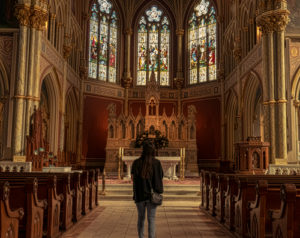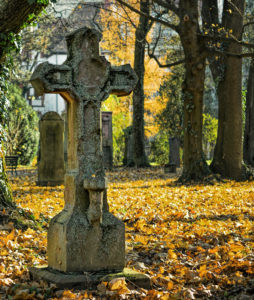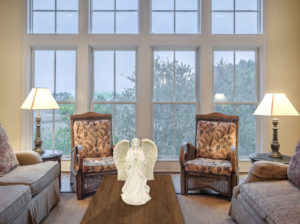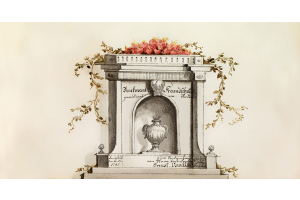
Vatican: Proper Disposition = Cemetery
In 2016, the Vatican published a directive, reminding Catholics that while cremation is an acceptable choice, there are still some limitations. Family members are to bury the remains in a “cemetery or other sacred place.” The directive noted that placement in a cemetery is vital to ensure that the person is remembered and prayed for by the Christian community at-large. Specifically, the Vatican forbade scattering the ashes in any way, or having the ashes preserved in any kind of memorial piece. The directive based the premise for this guidance on an effort to avoid “every appearance of pantheism, naturalism or nihilism.” The instruction was intended to serve as a clarification of the changing policies of the Roman Catholic Church concerning the disposition of human remains. The Vatican claims that remains must be kept sacred, and buried whole if at all possible. Although the church permits cremation for certain social, sanitary or economic reasons, it still leans heavily on the faithful to opt for a traditional church burial. The idea of scattering ashes at sea or keeping them in cremation jewelry falls far outside the original reasons that the Church allowed cremation in the first place. The Vatican continues to argue this so it should be obvious to Catholics that these kind of activities would not be allowed.
No Room at the Cemetery
Catholicism’s Conflicting Choices With Cremation
The awkwardness and inconsistency in the way that the Roman Catholic Church represents the act of cremation is not exactly new. In the 19th Century, the Church banned cremation as a viable choice for the faithful departed. Explicitly denying Last Rites to anyone who said they intended to be cremated. This policy changed in 1963, when the Church acknowledged that there were certain circumstances in which cremation might be acceptable. People who could not afford a traditional burial could be permitted to choose cremation, as long as they recognized that the body would rise during the Resurrection. For over 30 years, families who wished to have a Catholic burial for their loved ones were required to have funeral rites performed prior to cremation. In 1997, this policy was revised to permit certain funeral rites with cremated remains. The Church retains a strong preference for traditional burial ceremonies, but no longer denied a Catholic burial to those who had already been cremated. As long as the family could assure that their loved one only chose cremation for reasons compatible with Catholic dogma, they could have funeral and burial rites according to Church traditions.
An Impossible Situation for Families
This arms-length tolerance of cremation has the great potential to put families in a situation that is difficult or even impossible. Virtually anyone given the task of handling the final rest of a relative has an invested interest in ensuring that this person receives their proper due. The vast majority of the time, families want to honor a loved one’s wishes, and guarantee a good afterlife in accordance with their religious affiliation.
When Canon Becomes a Crisis
In heavily-populated regions where Catholic tradition is strong, the pressure to avoid cremation and opt for burial in a cemetery is creating crises for government officials. Nowhere is this more apparent than in Mexico City. Nearly 9 in 10 Mexican residents claim Catholicism as their religion. With a population of about 9 million and a metropolitan area of 21 million, Mexico City is packed tighter than any other metropolitan area in the Western hemisphere. Mexico City officials and religious authorities are trying to encourage cremation to limit families’ expenses of handling a loved one’s remains, and to take the pressure off already overcrowded cemeteries and crypts. The Roman Catholic Church’s assertion that cremated remains must be placed in a cemetery is creating a difficult situation for any faithful Catholic person who simply cannot get access to one. In some areas, Mexico City included, some people cannot find space in a cemetery, columbarium or crypt. No matter how much they are willing to pay. In turn, they end up keeping a loved one’s ashes at home, because a Church-sanctioned burial or placement of the ashes is literally not an option.
They may draw the Church’s anger and go against its policies through no fault of their own. The final disposition of a person’s earthly remains is an intensely personal and highly contentious subject, particularly within Catholicism. Many families decide to place a loved one’s ashes in an urn to keep at home, when the purchase of space in a cemetery is too expensive or merely unavailable. By blaming faulty beliefs for people’s decision not to place ashes in a cemetery, the Vatican may make choices even more difficult for families struggling to follow their religious teachings in a world that increasingly cannot accommodate them.











You're very welcome, and I would love to see the Monument you have been promoting once it's ready. I hope change can eventually come with how cremation is viewed throughout the Christian and Catholic communities. Have a wonderful weekend, God Bless.
I have this already and thank you very much for your reply. I have a NEW MONUMENT I am promoting now with the Christian Station FISH / SALEM which we have years of R & D invested along with a large financial investment.
We will be going International as soon as we ramp up, and i strongly believe we will help change the way most Christians and Catholics view cremation, and keeping your love ones ashes in the privacy of your own home to cherish each and everyday.
I will share it with you soon if you wish, as I would like your thoughts as well. God Bless. Michael
I definitely agree, I think everyone should be able to make their own choice in regards to what happens to their cremains or the cremains of their loved ones. The Pope does have several guidelines in regards to cremation. We pull most of our information from documents that come from the Vatican. The most recent document released in regards to cremation that I was able to locate is here, https://goo.gl/eztZWX. Hope this helps get you some more information.
Sincerely,
Susan Fraser
I have lived in the US all my life and to am Catholic. I have done years of due diligence on Burials and Rights and so called laws if you will for lack of a better word. I totally agree with this article.
It's not that we are wanting to go against the Popes guidelines as far as cremations are concerned, but for one, WE should be able to keep the Ashes of our loved one at home at least for a year or two if we wish as we still feel closer to them. Two, it's much easier or say good morning or good night with them in your own home. If you wish to out the urn in a niche in a year or two should be your chose, or keep them with you forever until you time comes, and hand them down to a son or daughter if that is your choice or they to wish the same. Do you have any documentation on this subject? As it says the Bishop may allow ashes to be kept at home in extraordinary cases. What does that MEAN??? If that is the case, it should be our right as long as you keep the whole body in a vessel as they state, and not spread them around, or in keep sakes. And in closing, if the General Public only knew what happens when it rains in parts of the country that caskets come out of the ground, and in a lot of cases float away with NO NAME ON THEM, or NEVER FOUND. And as in China, Japan, London, etc, they are OUT OF ROOM or very close to bury, or put in a niche. And as you may know 80% of the US will choose cremation by 2030. Then what chose will our grandchildren have, and then their children after that. We are far behind the truth, which it is just to expensive to be buried, and it is very expensive to purchase a niche and pay for the service of both cremation and burial of the urn. I look forward to any anformation you can give me where it says it OK for us to either keep the Ashes at home until you are ready to let go, or in fact, keep them forever. Thank you, Joy.